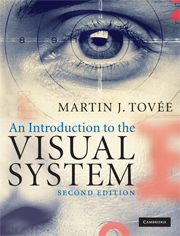Book contents
- Frontmatter
- Contents
- 1 Introduction
- 2 The eye and forming the image
- 3 Retinal colour vision
- 4 The organisation of the visual system
- 5 Primary visual cortex
- 6 Visual development: an activity-dependent process
- 7 Colour constancy
- 8 Object perception and recognition
- 9 Face recognition and interpretation
- 10 Motion perception
- 11 Brain and space
- 12 What is perception?
- References
- Index
- Plate sections
8 - Object perception and recognition
Published online by Cambridge University Press: 05 June 2012
- Frontmatter
- Contents
- 1 Introduction
- 2 The eye and forming the image
- 3 Retinal colour vision
- 4 The organisation of the visual system
- 5 Primary visual cortex
- 6 Visual development: an activity-dependent process
- 7 Colour constancy
- 8 Object perception and recognition
- 9 Face recognition and interpretation
- 10 Motion perception
- 11 Brain and space
- 12 What is perception?
- References
- Index
- Plate sections
Summary
From retinal image to cortical representation
In the primary stages of the visual system, such as Vl, objects are coded in terms of retinotopic co-ordinates, and lesions of Vl cause defects in retinal space, which move with eye movements, maintaining a constant retinal location. Several stages later in the visual system, at the inferior temporal cortex (IT) in non-human primates, the receptive fields are relatively independent of retinal location, and neurons can be activated by a specific stimulus, such as a face, over a wide range of retinal locations. Deficits that result from lesions of IT are based on the co-ordinate system properties of the object, independent of retinal location. Thus, at some point in the visual system, the pattern of excitation that reaches the eye must be transposed from a retinotopic co-ordinate system to a co-ordinate system centred on the object itself (Marr, 1982). An outline of such a transformation can be seen in Table 8.1.
At the same time that co-ordinates become object centred, the system becomes independent of the precise metric regarding the object itself within its own co-ordinate system, that is to say the system remains responsive to an object despite changes in its size, orientation, texture and completeness. Single-cell recording studies in the macaque suggest that, for face processing, these transformations occur in the anterior IT. The response of the majority of cells in the superior temporal sulcus (STS) is view-selective and their outputs could be combined in a hierarchical manner to produce view-independent cells in the inferior temporal cortex.
- Type
- Chapter
- Information
- An Introduction to the Visual System , pp. 109 - 132Publisher: Cambridge University PressPrint publication year: 2008



